九年级英语写作教学案例
- 格式:doc
- 大小:29.00 KB
- 文档页数:3
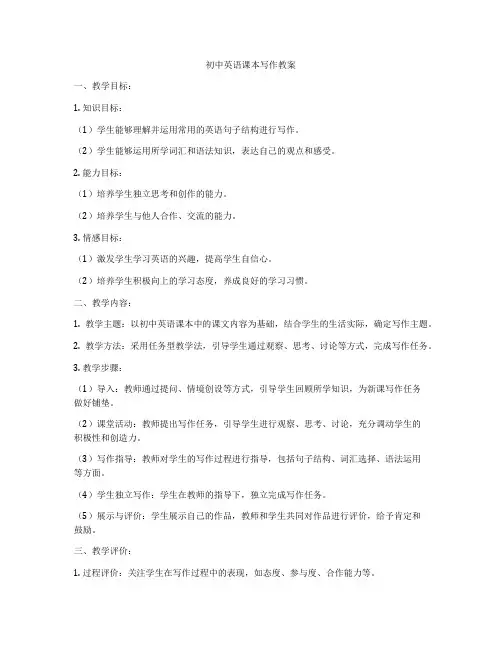
初中英语课本写作教案一、教学目标:1. 知识目标:(1)学生能够理解并运用常用的英语句子结构进行写作。
(2)学生能够运用所学词汇和语法知识,表达自己的观点和感受。
2. 能力目标:(1)培养学生独立思考和创作的能力。
(2)培养学生与他人合作、交流的能力。
3. 情感目标:(1)激发学生学习英语的兴趣,提高学生自信心。
(2)培养学生积极向上的学习态度,养成良好的学习习惯。
二、教学内容:1. 教学主题:以初中英语课本中的课文内容为基础,结合学生的生活实际,确定写作主题。
2. 教学方法:采用任务型教学法,引导学生通过观察、思考、讨论等方式,完成写作任务。
3. 教学步骤:(1)导入:教师通过提问、情境创设等方式,引导学生回顾所学知识,为新课写作任务做好铺垫。
(2)课堂活动:教师提出写作任务,引导学生进行观察、思考、讨论,充分调动学生的积极性和创造力。
(3)写作指导:教师对学生的写作过程进行指导,包括句子结构、词汇选择、语法运用等方面。
(4)学生独立写作:学生在教师的指导下,独立完成写作任务。
(5)展示与评价:学生展示自己的作品,教师和学生共同对作品进行评价,给予肯定和鼓励。
三、教学评价:1. 过程评价:关注学生在写作过程中的表现,如态度、参与度、合作能力等。
2. 成果评价:评价学生写作作品的质量,如内容完整性、语言准确性、创意性等。
3. 情感评价:关注学生在学习过程中的情感变化,如兴趣、自信心、学习动力等。
四、教学资源:1. 教材:初中英语课本。
2. 辅助材料:相关写作话题的图片、视频、文章等。
3. 教学设备:投影仪、电脑、黑板等。
五、教学建议:1. 注重培养学生的语言基础,提高学生的词汇量和语法水平。
2. 鼓励学生多阅读,拓宽视野,积累写作素材。
3. 教师应给予学生足够的关爱和支持,关注学生个体差异,调整教学策略。
4. 创设良好的学习氛围,让学生在轻松愉快的环境中学习英语。
5. 定期进行写作训练,提高学生的写作能力。
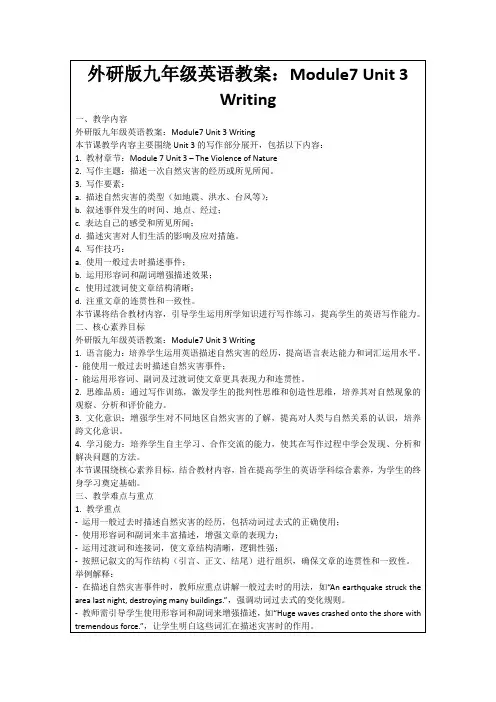

初中英语作文教案一、教学目标:1.能够掌握基本的英语作文写作技巧;2.能够运用所学知识,写出简单、连贯、有逻辑的英语作文;3.培养学生的英语写作兴趣,提高写作能力。
二、教学重点:1.培养学生的写作兴趣;2.教授基本的英语写作技巧;3.激发学生的写作创造力。
三、教学难点:1.如何培养学生的写作兴趣;2.如何激发学生的写作创造力。
四、教学内容:1.教师引导学生阅读范文,分析范文结构、语言表达等;2.教师讲解英语作文写作技巧,如句型搭配、词汇运用等;3.教师指导学生进行写作训练,如写作练习、写作指导等;4.教师布置作业,让学生在家继续练习写作。
五、教学过程:1.教师引导学生阅读范文,分析范文结构、语言表达等,激发学生的写作兴趣;2.教师讲解英语作文写作技巧,如句型搭配、词汇运用等,提高学生的写作能力;3.教师指导学生进行写作训练,如写作练习、写作指导等,培养学生的写作技能;4.教师布置作业,让学生在家继续练习写作,巩固所学知识。
六、教学方法:1.导入法,通过引导学生阅读范文,激发学生的写作兴趣;2.讲授法,通过讲解英语作文写作技巧,提高学生的写作能力;3.示范法,通过指导学生进行写作训练,培养学生的写作技能;4.作业法,通过布置作业,巩固所学知识,提高学生的写作水平。
七、教学手段:1.多媒体课件,用于展示范文、写作技巧等;2.教学实物,如英语作文书籍、写作范文等;3.黑板报,用于记录重点、难点内容,帮助学生复习。
八、教学检查与评价:1.教师在课堂上进行实时检查,发现学生写作中的问题并及时纠正;2.教师在课后进行作业批改,对学生的写作进行评价,指导学生改进。
九、教学反思:1.教师要及时调整教学方法,根据学生的实际情况进行针对性教学;2.教师要注重培养学生的写作兴趣,激发学生的写作热情;3.教师要关注学生的写作能力提高情况,及时进行评价和指导。
初中英语作文教案到此结束,希望本教案能够帮助到广大英语教师,提高学生的写作水平。
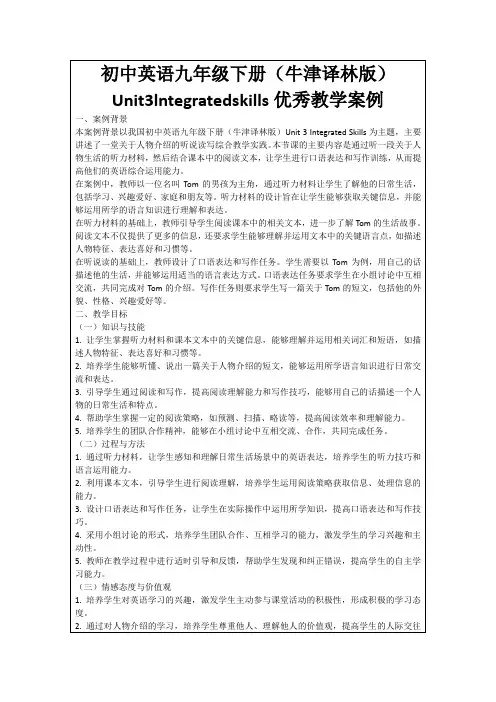
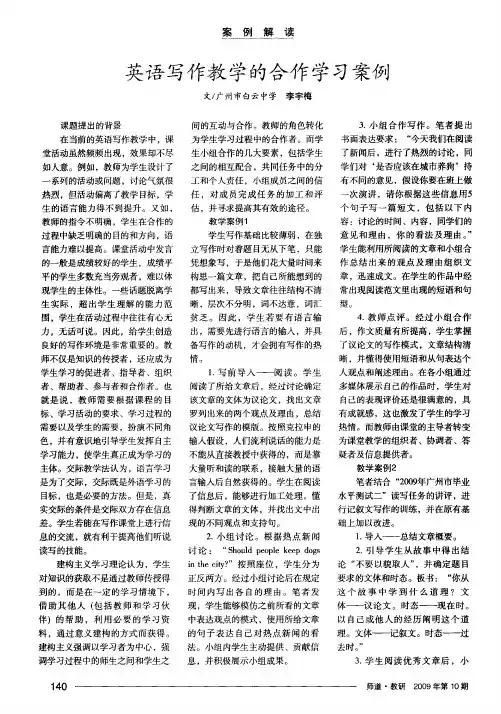
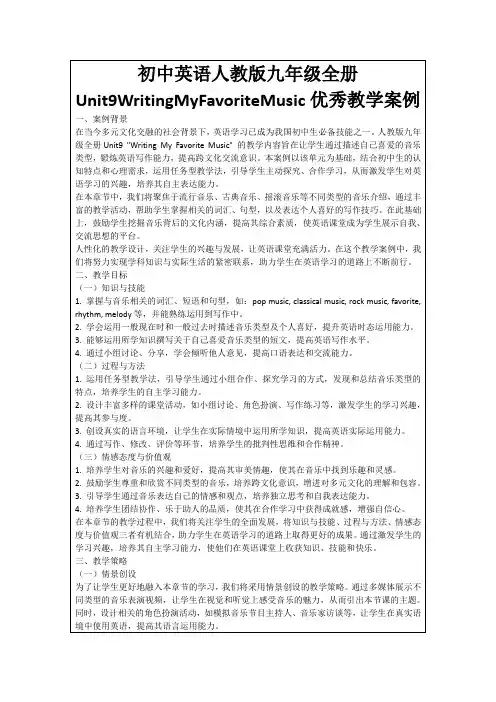
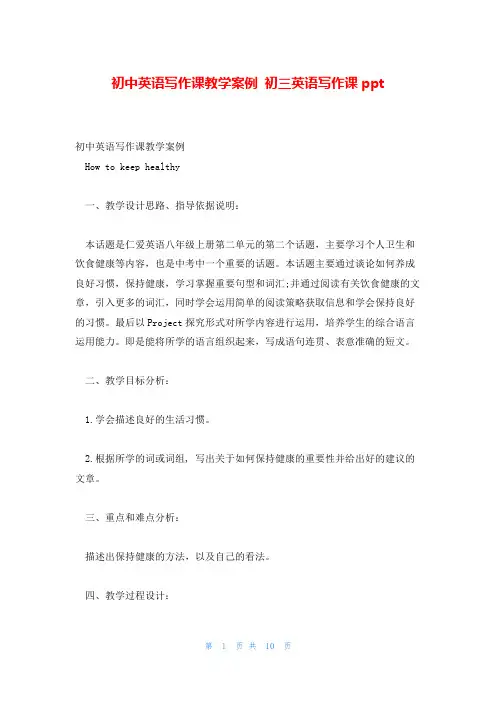
初中英语写作课教学案例初三英语写作课ppt初中英语写作课教学案例How to keep healthy一、教学设计思路、指导依据说明:本话题是仁爱英语八年级上册第二单元的第二个话题,主要学习个人卫生和饮食健康等内容,也是中考中一个重要的话题。
本话题主要通过谈论如何养成良好习惯,保持健康,学习掌握重要句型和词汇;并通过阅读有关饮食健康的文章,引入更多的词汇,同时学会运用简单的阅读策略获取信息和学会保持良好的习惯。
最后以Project探究形式对所学内容进行运用,培养学生的综合语言运用能力。
即是能将所学的语言组织起来,写成语句连贯、表意准确的短文。
二、教学目标分析:1.学会描述良好的生活习惯。
2.根据所学的词或词组, 写出关于如何保持健康的重要性并给出好的建议的文章。
三、重点和难点分析:描述出保持健康的方法,以及自己的看法。
四、教学过程设计:Step 1. Lead in: 通过讨论下面的问题,引出本节课的大任务。
吸引学生,激发其学习兴趣,提高学生作为学习主体课堂参与意识。
列一个目录在黑板1. How often do you exercise ?2. How often do you eat vegetables?3. How often do you eat fruit ?4. How many hours do you sleep every night ?5. How often do you drink milk ?6. How often do you eat junk food ?7. How often do you drink coffee ?Step 2.Revision 让学生先以小组的形式复习section A 和section B的内容,使用大脑风暴法让学生brainstorm说出一些食物名称和healthy 有关的单词短语和句子,目的是激活学生头脑中和写作话题keep healthy 相关的东西来酝酿写作的思路,以便写作时能选择有意义的东西。
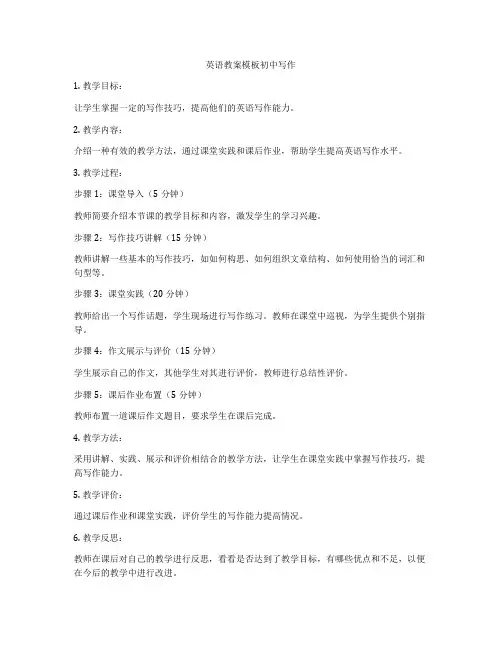
英语教案模板初中写作1. 教学目标:让学生掌握一定的写作技巧,提高他们的英语写作能力。
2. 教学内容:介绍一种有效的教学方法,通过课堂实践和课后作业,帮助学生提高英语写作水平。
3. 教学过程:步骤1:课堂导入(5分钟)教师简要介绍本节课的教学目标和内容,激发学生的学习兴趣。
步骤2:写作技巧讲解(15分钟)教师讲解一些基本的写作技巧,如如何构思、如何组织文章结构、如何使用恰当的词汇和句型等。
步骤3:课堂实践(20分钟)教师给出一个写作话题,学生现场进行写作练习。
教师在课堂中巡视,为学生提供个别指导。
步骤4:作文展示与评价(15分钟)学生展示自己的作文,其他学生对其进行评价,教师进行总结性评价。
步骤5:课后作业布置(5分钟)教师布置一道课后作文题目,要求学生在课后完成。
4. 教学方法:采用讲解、实践、展示和评价相结合的教学方法,让学生在课堂实践中掌握写作技巧,提高写作能力。
5. 教学评价:通过课后作业和课堂实践,评价学生的写作能力提高情况。
6. 教学反思:教师在课后对自己的教学进行反思,看看是否达到了教学目标,有哪些优点和不足,以便在今后的教学中进行改进。
7. 教学资源:教师准备相关的写作技巧资料,如范文、写作指导等,以便在课堂上进行讲解和示范。
8. 教学时间:一节课(45分钟)9. 教学对象:初中生10. 教学重点:让学生掌握一定的写作技巧,提高他们的英语写作能力。
11. 教学难点:如何引导学生运用所学的写作技巧进行实际写作。
通过以上教案,教师可以有效地提高学生的英语写作能力,让学生在课堂实践中掌握写作技巧,提高他们的英语水平。
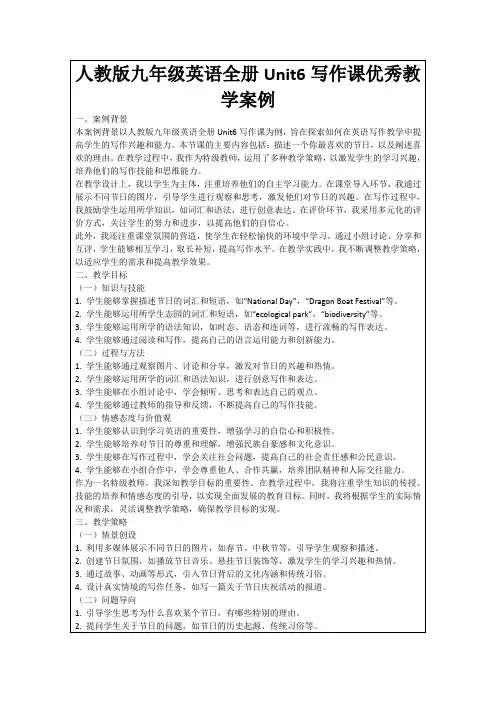
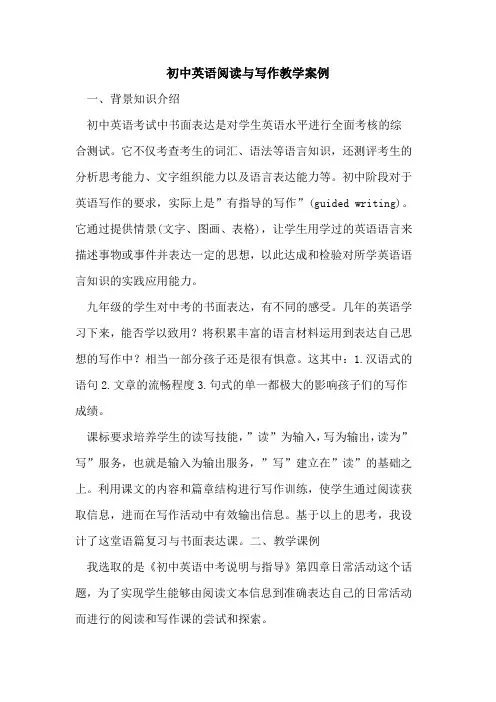
初中英语阅读与写作教学案例一、背景知识介绍初中英语考试中书面表达是对学生英语水平进行全面考核的综合测试。
它不仅考查考生的词汇、语法等语言知识,还测评考生的分析思考能力、文字组织能力以及语言表达能力等。
初中阶段对于英语写作的要求,实际上是”有指导的写作”(guided writing)。
它通过提供情景(文字、图画、表格),让学生用学过的英语语言来描述事物或事件并表达一定的思想,以此达成和检验对所学英语语言知识的实践应用能力。
九年级的学生对中考的书面表达,有不同的感受。
几年的英语学习下来,能否学以致用?将积累丰富的语言材料运用到表达自己思想的写作中?相当一部分孩子还是很有惧意。
这其中:1.汉语式的语句2.文章的流畅程度3.句式的单一都极大的影响孩子们的写作成绩。
课标要求培养学生的读写技能,”读”为输入,写为输出,读为”写”服务,也就是输入为输出服务,”写”建立在”读”的基础之上。
利用课文的内容和篇章结构进行写作训练,使学生通过阅读获取信息,进而在写作活动中有效输出信息。
基于以上的思考,我设计了这堂语篇复习与书面表达课。
二、教学课例我选取的是《初中英语中考说明与指导》第四章日常活动这个话题,为了实现学生能够由阅读文本信息到准确表达自己的日常活动而进行的阅读和写作课的尝试和探索。
教学目标:1.通过对课文的阅读和分析,学生能:掌握谈论日常活动的短语和句型。
掌握语篇的结构,关注语篇的常用时态,并合理运用关联词。
2.运用本节课所复习的短语、句型及语篇结构,完成写作任务”描写自己和家人的日常活动”。
教学设计1、总体思路在教学中,我选取了教材中与日常活动相关的两篇阅读文章作为阅读材料,让学生了解文章的时态、句子与句子之间的逻辑关系,引导学生在阅读文章时分析其语言、体裁、内容和语篇结构,引导学生理解写作的意图与目的,抓住主题句,理解细节与主题之间的关系,帮助学生掌握写作的基本框架和技巧。
2、教学过程step 1 revision ①使用头脑风暴法(brainstorm)让学生想出一些和日常活动有关的单词短语,目的是激活学生头脑中和写作话题daily activities 相关的知识,并把它们分成生活起居、家务学习和课余生活三个方面。
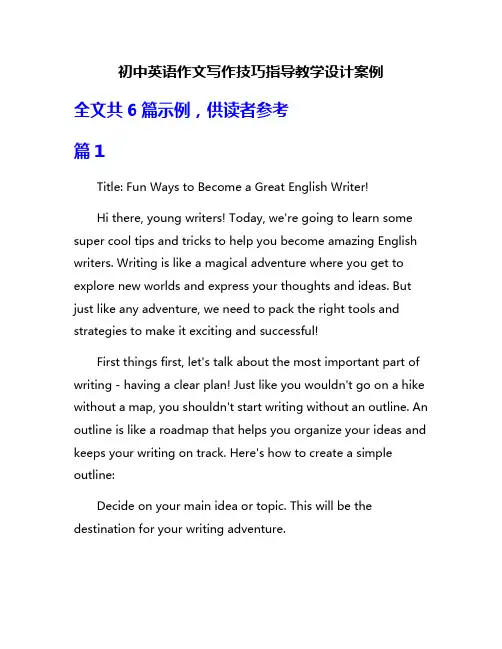
初中英语作文写作技巧指导教学设计案例全文共6篇示例,供读者参考篇1Title: Fun Ways to Become a Great English Writer!Hi there, young writers! Today, we're going to learn some super cool tips and tricks to help you become amazing English writers. Writing is like a magical adventure where you get to explore new worlds and express your thoughts and ideas. But just like any adventure, we need to pack the right tools and strategies to make it exciting and successful!First things first, let's talk about the most important part of writing - having a clear plan! Just like you wouldn't go on a hike without a map, you shouldn't start writing without an outline. An outline is like a roadmap that helps you organize your ideas and keeps your writing on track. Here's how to create a simple outline:Decide on your main idea or topic. This will be the destination for your writing adventure.Brainstorm supporting details or examples. These will be the pit stops along the way.Arrange your supporting details in a logical order. This will be your route.Add an introduction and conclusion. These are like the starting and ending points of your journey.With your outline in hand, you're ready to start writing! But wait, there's more! Let's talk about making your writing interesting and engaging.One way to do this is by using vivid descriptions. Imagine you're painting a picture with your words. Use adjectives (describing words) to add color and detail to your writing. For example, instead of saying "the dog," you could say "the fluffy, energetic golden retriever."Another way to make your writing pop is by using strong verbs. Verbs are action words, and they can really bring your writing to life. Instead of saying "she walked," you could say "she sprinted" or "she tiptoed."Don't forget about adding personal experiences, examples, and anecdotes to your writing. These little stories and details willhelp your readers connect with your ideas and make your writing more relatable and memorable.Of course, no great adventure is complete without a few challenges along the way. When it comes to writing, one of the biggest challenges is revising and editing your work. But don't worry, we've got some tips to make it easier!First, try reading your writing out loud. This can help you catch mistakes and awkward phrasing that you might have missed while reading silently. You can also ask a friend or family member to read your writing and provide feedback.Another helpful strategy is to take a break from your writing and come back to it with fresh eyes. Sometimes, stepping away for a little while can give you a new perspective and help you spot areas that need improvement.Finally, don't be afraid to seek help from your teacher or a writing tutor. They're like expert guides who can offer valuable advice and support to help you become a better writer.Writing may seem like a daunting task at first, but with practice and these handy tips, you'll be embarking on amazing writing adventures in no time! Remember, every great writerstarted somewhere, and with hard work and dedication, you too can become a master storyteller and wordsmith.So grab your pen (or keyboard), pack your outline, and let's hit the trail to writing success! Happy writing, adventurers!篇2Title: Super Cool Tips for Writing Awesome English Essays!Hi friends! Are you a middle school student who struggles with writing English essays? Don't worry, I've got your back! As a wise old elementary school kid, I've learned some really neat tricks to help make essay writing easier and way more fun. Get ready to become an essay master!First up, let's talk about picking a totally rad topic. Your teacher might assign you a subject, but sometimes you get to choose whatever you want to write about. If that's the case, pick something you're really interested in and excited to discuss. Maybe you're obsessed with video games, or perhaps you can't get enough of dinosaurs or candy. Whatever floats your boat! Writing about stuff you love makes the whole process a million times more enjoyable.Once you've nailed down your subject, it's time to get those brilliant ideas flowing. Spend some time brainstorming everything you can think of related to your topic. Don't hold back! Write down anything and everything that pops into your head, even if it seems silly at first. You can sort out the good ideas from the wacky ones later.Now that you've got a jumping off point, you'll want to organize all those amazing thoughts into a solid plan. This is where the classic five paragraph essay structure comes in handy. That's an intro paragraph to get things started, three jam-packed body paragraphs to explore your key points, and a high-impact conclusion to leave your reader wowed. Mapping out your ideas into an outline makes putting the actual essay together a total breeze.Okay, time to dive into the writing itself! Don't be intimidated by staring at that blank page. Just take itstep-by-step, section-by-section. Start with a hook in your intro to grab the reader's attention right away. You could ask a thought-provoking question, share an interesting fact, or tell a funny joke related to your topic. Anything to pique their curiosity! Then, preview the main points you'll cover in the essay so your reader knows what to expect.Each of your body paragraphs needs to focus on one of the key ideas from your outline. Kick things off with a strong topic sentence that states the main point you'll explore. Then back it up with lots of juicy examples, details, facts, quotes, or personal experiences to make your case. Don't just tell, show with vivid descriptions to pull your reader into the action! Also, make sure to analyze and explain why the evidence you provide supports your point.Once you've unpacked all your main points, it's time to bring it on home with your conclusion. This is the perfect opportunity to reinforce why your topic is so fascinating and drive your message home one last time. You could restate your key ideas, add a thought-provoking question for readers to ponder, share a personal anecdote that sums things up, or challenge your audience to take some sort of action. Just avoid introducing any brand new concepts. A conclusion should provide a sense of closure and circular back to your hook.Through each step, always keep your reader in mind. Your essay should flow smoothly with clear transitions between sentences and paragraphs to help your audience easily follow along. Use a variety of sentences structures and vocabulary words to keep things interesting, but don't go overboard withcomplex terms that could confuse your reader. The goal is to explain your thoughts in a straightforward, engaging way.I know, I know... you're probably wondering about pesky things like grammar, spelling, and mechanics. Those are definitely important, but don't get bogged down worrying about every little detail on your first draft. Just get your ideas out onto the page first. You can always revise and polish things up later. Reading your essay aloud can really help you catch and fix any awkward phrasing or errors.Last but not least, don't forget to give your essay an awesome title! Choose something catchy that sums up your main idea and makes readers curious to dive in.And there you have it, all my top tips for crafting an A+ English essay. Just take it one step at a time, stay organized, write about something you're pumped about, and pour your personality onto the page. Before you know it, you'll be churning out killer essays left and right!So what are you waiting for? Grab a snazzy notebook, your favorite pencil or computer, and get to brainstorming that next masterpiece. You've got this!Happy writing, rock stars!篇3Title: Tips for Writing Awesome English Compositions!Hey there, fellow students! Are you struggling with writing compositions in your English class? Don't worry; I've got some super-cool tips to share with you. Writing can be a lot of fun once you get the hang of it, and with these tricks up your sleeve, you'll be impressing your teachers and classmates in no time!First things first, let's talk about the most important part of any composition – the topic! Choosing an interesting and exciting topic is key to keeping your readers engaged from start to finish. Don't just pick something boring like "My Summer Vacation" or "My Favorite Food." Instead, think about things that fascinate you or make you curious. Maybe you're really into dinosaurs, or you love exploring space and the mysteries of the universe. Whatever your passion is, let that shine through in your topic choice.Next up, we've got the introduction. This is where you'll hook your readers and give them a sneak peek of what's to come.A great way to start is by asking a thought-provoking question or sharing an interesting fact related to your topic. For example, if you're writing about dinosaurs, you could ask, "Did you knowthat the Tyrannosaurus Rex had teeth as big as bananas?" Or, if you're writing about space exploration, you could share amind-blowing statistic like, "There are more stars in the universe than grains of sand on all the beaches of the world." See? Now you've got your readers' attention!Once you've got them hooked, it's time to dive into the body paragraphs. This is where you'll flesh out your ideas and support them with juicy details and examples. Remember, each paragraph should focus on one main idea, and you'll want to use transition words (like "firstly," "additionally," and "moreover") to help your writing flow smoothly from one point to the next.Don't forget to back up your claims with evidence! If you're writing about dinosaurs, you could include facts and figures from reliable sources, like museums or science websites. If you're writing about space, you might want to quote famous astronauts or include snippets from NASA reports. The more specific and concrete your examples are, the stronger your composition will be.Now, let's talk about something that can make or break your composition: vocabulary! Using a variety of interesting and descriptive words can really bring your writing to life. Instead of saying something is "big," you could call it "colossal" or"gargantuan." Instead of saying something is "cool," you could describe it as "fascinating" or "captivating." The more colorful your language, the more engaging your composition will be.But be careful – you don't want to overdo it with big, fancy words that you don't fully understand. That's a surefire way to confuse your readers and undermine your credibility. Stick to words you're comfortable with, and if you're unsure about the meaning or usage of a word, look it up or ask your teacher for guidance.As you're nearing the end of your composition, it's time to start thinking about your conclusion. This is where you'll wrap everything up and leave your readers with a lasting impression. A great conclusion should summarize your main points and tie everything together in a neat little bow. You might also want to include a thought-provoking question or a call to action that encourages your readers to think more deeply about the topic.Finally, don't forget to proofread, proofread, proofread! Even the best writers make mistakes, so it's crucial to go over your work with a fine-toothed comb. Check for spelling and grammar errors, as well as any awkward phrasing or unclear sentences. You might even want to read your composition out loud to catch any areas that sound clunky or confusing.And there you have it, my friends – the secret sauce to writing amazing English compositions! Remember, practice makes perfect, so don't be discouraged if your first few attempts aren't masterpieces. Keep writing, keep learning, and keep having fun with it. Before you know it, you'll be a composition-writing pro!篇4Writing Great English Essays in Middle School - A Kid's GuideHey everyone! Are you a middle schooler who has to write essays in English class? I know it can seem really hard and boring at first. But don't worry, I'm going to share some tips that will help make your essay writing much easier and way more fun!First off, let's talk about getting started on your essay. The very first step is to carefully read the instructions or prompt your teacher gives you. What is the essay supposed to be about? What kind of essay do you need to write - persuasive, narrative, expository? Knowing this will help guide the whole process.Once you know the topic and type of essay, it's time to start brainstorming ideas! Get a piece of paper or open a document on your computer and just start writing down anything that comes to mind about the topic. Don't worry about completesentences or organization yet, just get all your thoughts out there. You can use diagrams or make lists too if that helps spark ideas.After brainstorming, start sorting through and organizing your ideas into an outline. This will be the road map for your essay. A solid outline has an introduction paragraph, body paragraphs with supporting details, and a conclusion paragraph. Each body paragraph should have one clear main idea.Okay, now for some tips on actually writing the essay itself! The introduction paragraph needs to grab the reader's attention right away with an interesting hook. This could be a question, fun fact, or bold statement related to your topic. Then, introduce what your essay will be about and wrap it up with a clear thesis statement.Next up are the body paragraphs, where you'll lay out all your supporting points and evidence for your thesis. A good trick is to start each body paragraph with a topic sentence that sums up the main idea you'll cover. Then use examples, facts, explanations and analysis to back that point up. Don't forget to include transitions between paragraphs to help everything flow smoothly.For the conclusion paragraph, start by restating your thesis in a new way. Then summarize the key points you made in the body paragraphs. Try to leave the reader with something powerful and thought-provoking to ponder after finishing your essay.While you're writing, remember to use a variety of vocabulary words, literary techniques like similes and metaphors, and different types of sentences (simple, compound, complex). This makes your writing way more engaging and shows off your skills. But be careful not to overuse fancy words either - write in a natural style.Another important thing is to stick to the required formatting and guidelines, like heading, title, spacing, font, word count etc. It shows you can follow directions carefully. And of course, proofread thoroughly for spelling, grammar and other errors before handing in your final draft.I know writing essays can seem like a drag, but look at it this way - you're getting awesome communication skills that will help you out big time in the future with jobs, school applications, and just about everything! The more you practice essay writing now, the easier it will become.So don't stress, use these tips and you'll be cranking out A+ English essays in no time! Let me know if you have any other questions. Now get out there and start writing!篇5Title: Become a Writing Superhero! Tips for Awesome English EssaysHi there, elementary school friend! Are you ready to become a writing superhero? I'm going to share some super cool tips to help you write amazing English essays when you get to middle school. Get ready to power up your writing skills!First things first - every superhero needs a great origin story. For your essay, that's the introduction paragraph. This is where you grab the reader's attention with an awesome opening line. Try asking a question, telling a joke, or sharing an interesting fact related to your essay topic. Then you'll want to clearly state your main idea or thesis statement. This is like revealing your superhero identity and superpowers!Once you've suited up with that intro, it's time for the most important part - the body paragraphs! This is where you get to show off all your best evidence and examples, just like asuperhero battles the villains. Ideally, you'll want 3-5 body paragraphs.For each body paragraph, start by stating the main idea in a clear topic sentence. This helps focus your writing, just like a superhero's laser vision! Then you'll want to provide detailed examples, facts, and explanations to back up that main idea. Use super vivid and descriptive language to really paint a picture for your reader. Don't be afraid to use sensory details about sights, sounds, smells, tastes, or textures.To make your paragraphs flow smoothly, be sure to include transitions words like "first," "next," "additionally," "moreover," etc. Transitions are like your superhero's grappling hook, swinging the reader effortlessly from one idea to the next!Need to cite evidence from other sources? No problem! Use clear quotes or paraphrased information, and always cite your sources to avoid any literary kryptonite (aka plagiarism). Be sure to analyze and explain how your evidence supports your point - you're the superhero, not the quoted author!As your body paragraphs start to wrap up, get ready for the exciting conclusion - the final showdown between your superhero and the villain! In your conclusion paragraph, you'll summarize your main points by restating your thesis in a newway. Then finish strong by relating your topic back to the "real world" with insights, opinions, or a call to action.Just like any superhero movie's climactic battle, you want to leave your reader feeling totally wowed and excited about what they just experienced. Maybe you'll inspire them to fight for the same cause as your thesis statement!Once you've crafted your super essay from intro to conclusion, it's time for some final editing and polishing. Read through your work a few times, making sure:Every paragraph relates to your thesisYour evidence and examples are clear and effectiveYou've checked for proper grammar, spelling, and punctuationYour language and tone are appropriate for the audienceEditing is like giving your superhero costume those final adjustments before heading off to face evil! When you're all set, turn in that essay feeling confident and proud.Writing may seem tough at first, kind of like lifting a boulder over your head. But with practice and using these tips, you'll be a lean, mean, essay-writing machine! I can't wait to read yoursuper adventures in middle school English class. What heroic tales will you tell?篇6How to Write a Rocking English EssayHey kids! Are you struggling with writing English essays for school? Don't worry, I've got your back! Follow my tips and tricks, and you'll be churning out A+ essays in no time. Let's get started!First things first, what even is an essay? It's just a bunch of paragraphs where you write about a topic and share your ideas and opinions. See, not so scary, right?Now, every good essay needs to start with a bang! You want to hook your reader from the very first sentence. Think of a really cool fact, question, or story related to your topic that will grab their attention. If you're writing about dogs, you could start with "Did you know dogs have better low-light vision than humans?" See how that makes you curious to read more?Okay, after that killer opening line, it's time to write your introduction paragraph. This is where you'll state your main idea or thesis statement. Basically, it's a one-sentence summary ofwhat your whole essay will be about. For example: "Dogs make great pets because they are loyal, intelligent, and loving companions." Bam! Short and sweet.Now we're getting into the good stuff - the body paragraphs. This is where you'll expand on your main idea with examples, details, facts, and reasons to support your point. Maybe you'll have one paragraph explaining why dogs are loyal, then another on their intelligence, then another on how loving they are.Each body paragraph should start with a topic sentence that summarizes what that paragraph is about. Then you'll write 4-6 sentences explaining that point in detail using examples from your own experiences, things you've read, or just logical reasoning. Does that make sense?To make your body paragraphs flow nicely, you'll want to use transition words like "firstly", "additionally", "for example", "furthermore". They're like little bridges connecting your ideas together.Once you've made all your points in the body, it's time to wrap things up with a strong conclusion paragraph. This is where you'll restate your thesis in a new way and leave your reader with something interesting to think about. You can end with athought-provoking question, call to action, or memorable quote related to your topic.When you're all done writing, be sure to read through your essay and check for any silly grammar, spelling, or punctuation mistakes. It's also great to have a parent, teacher, or friend read it over and give you feedback.The biggest keys to writing a stellar English essay are to 1) Start with an engaging hook, 2) State your thesis clearly, 3) Support your main idea thoroughly in the body paragraphs, 4) Use transition words, and 5) Have an impactful conclusion. Got all that?Of course, practice makes perfect. So write, write, write! The more you practice, the easier it will become to organize your thoughts into a logical essay. Before you know it, you'll be a total pro.Don't get discouraged if your first few essays aren't masterpieces - it takes time and effort to become a great writer. Just have fun with it, let your creativity shine, and pretty soon you'll be earning essay awards left and right!So what are you waiting for? Grab a pencil and start jotting down some killer ideas for your next English essay. You've got this!。
一、引言英语写作教学是初中英语教学的一项重要内容,也是学生掌握比较薄弱的一环。
我们应抓好基本功的训练、开展形式多样的写作训练、进行行之有效的讲、评、改,以切实有效地提高学生的英语写作技能。
二、抓好基本功的训练写作是语言的输出,应建立在语言材料输入的基础上,如果学生没有关于主题信息的知识输入,没有正确的英语词法、句法、语段和语篇结构特征等知识,就很难实现正确的语言输出。
俗话说:“巧妇难为无米之炊”。
因此,要想写好作文,就必须抓好基础。
1.听写练习听写每个单元的重点单词、短语和句子。
听写练习既能练听又能练写,一方面检验了听的理解,另一方面也有助于提高写的速度及准确性,还可巩固所学内容,为写作打下坚实的基础。
2.说的练习每节课前几分钟,可采用值日生报告制,内容不限,可以是读过的小故事、也可以是自己的习作;教师也可就上节课所学内容进行一连串的提问,或让学生把所学对话改写成短文等。
通过这种说的练习,让学生注意时态、语态、人称和前后的逻辑关系,从而为写作打下基础。
3.词组识记以及固定表达句型背诵在教学中要求学生多识记词组。
词组就是单词根据语用实际形成的一种约定俗成的固定搭配。
如果想写出或说出地道的英语,就要用那些约定俗成的词组。
例如,表达吃药的词组是“takemedicine”而不是“drinkmedicine”或“eatmedicine”。
记住词组haveagoodtime意义及用法,写作中就不会出现“Iplayedhappily”汉语式的错误了。
英语中有许多比较固定的表达方式,如:Iamafraidthat….Itishardto…等,掌握了它们,对学生写作大有裨益。
4.五种简单句的句型结构训练五种简单句是指以下基本句型:SV、SVP、SVO、SVOC、SVOO。
英语中千变万化的句子归根到底都离不开这五个基本句型,因此对这五个基本句型的训练就尤为重要。
三、开展形式多样的写作训练1.英汉互译练习每个单元都有一两个重点句型,让学生进行英汉互译,可进行两种语言的对比,提高学生对英语语言的敏感度,从而在写作中有意识地避免母语干扰,正确使用英语语言。
九年级英语上册Unit4 Stories and poems Lesson24 Writing a Poem教学设计新版冀教版一. 教材分析冀教版九年级英语上册Unit4 Stories and poems Lesson24 Writing a Poem是一个写作课。
本课的主题是学习写一首诗,通过欣赏和分析不同类型的诗歌,让学生掌握诗歌的基本结构和修辞手法,并能够创作一首属于自己的诗歌。
教材内容丰富,包括不同风格的诗歌示例、诗歌创作技巧指导和学生的创作实践。
二. 学情分析九年级的学生已经具备了一定的英语基础,能够理解和运用一些基本的英语句型和词汇。
然而,诗歌创作对于他们来说可能是一个新的挑战,需要引导学生充分发挥想象力和创造力。
此外,学生可能对诗歌的修辞手法和结构有一定的陌生感,因此需要教师在教学中进行详细的讲解和示范。
三. 教学目标1.能够理解并运用诗歌中的常用词汇和句型。
2.能够欣赏并分析不同类型的诗歌,理解诗歌的基本结构和修辞手法。
3.能够创作一首属于自己的诗歌,展示想象力和创造力。
4.培养对英语诗歌的兴趣和鉴赏能力。
四. 教学重难点1.诗歌中的修辞手法和结构的理解。
2.学生创作诗歌的能力的培养。
五. 教学方法1.任务驱动法:通过设定具体的写作任务,引导学生主动学习和参与。
2.案例分析法:通过分析不同类型的诗歌案例,让学生理解和掌握诗歌的基本结构和修辞手法。
3.互动式教学法:通过教师与学生、学生与学生之间的互动,激发学生的学习兴趣和创造力。
六. 教学准备1.准备不同类型的诗歌案例,包括示例和分析。
2.准备诗歌创作技巧的指导资料。
3.准备写作任务的要求和评价标准。
七. 教学过程1.导入(5分钟)通过展示一首美丽的英文诗歌,引发学生对诗歌的兴趣,并引导学生思考诗歌的特点和魅力。
2.呈现(10分钟)呈现不同的诗歌案例,让学生欣赏和分析。
引导学生关注诗歌的主题、结构、修辞手法等,并通过讨论和分享,让学生表达对诗歌的理解和感受。
初三英语写作课教案看看初三老师们英语的写作课教案是怎样设计的?下面是WTT 给大家整理的初三英语写作课教案,供大家参阅!初三英语写作课教案--外研版九年级上module10-how to keep healthy大庆五十五中学刘春英本节课是以九年级上module10以“健身”(fitness)为话题展开,要求学生写一篇“保持健康(how to keep healthy)”的说明文来表达提倡健康的建议,合理的饮食以及健康的生活理念。
在生活质量普遍提高的今天,健康已经成为十分重要的生活质量指标,人们对之给予了极大的关注。
因此,在中学阶段的英语教学活动中倡导健康的生活理念,对中学生的成长具有现实指导意义。
一、教学设计通过运用过程写作教学模式:预写作--打草稿--修改--校订定稿-评价-展示,我从创设情景,利用有关健康的一些日常习惯的图片引导学生形成特定的写作情感氛围,激发学生大脑中的图式及背景知识,使学生积极参与语言实践活动,激发学生达到写作兴奋点。
接着,通过引导学生开展头脑风暴活动,提供有关保持健康的有用句型及结构,让学生认识到保护健康的必要性,并主动寻求解决这一问题的方法:保持健康。
帮助学生自主获取足够的写作信息,让情景与本模块的语言产生直接的联系,形成英语思维环境---即把情景里所出现的问题和语言结合起来,然后在联想中表达,很自然地就过渡到了今天的写作任务:去写一篇说明文来提出有关保持健康的建议。
在学生提出方法的时候给学生提供很多句型供学生选择性的应用到自己的表达中去。
二、教学反思同学们各抒己见,通过主动分析,讨论,理清了自己的写作思路,得出了该类文体的写作提纲,以及自己的切实可行的写作提纲,收集了写作需要的词汇、句型。
通过这种方式,改变了以往没什么写,不知道范文的局面,充分调动了学生的写作主动性和积极性,引导学生自主地探究和运用写作方法和知识,更深入地教会了学生掌握写作过程的思维方式和语言技能,培养了学生发现问题、分析问题和解决问题的能力以及交流合作的能力。
基于思维导图的初中英语写作课教学案例与思考——以译林版牛津英语9A Unit4 Task 为例【摘要】写作是英语教学的重点。
写作内容的凌乱、中心不明确、缺乏创造性、文章写不出等问题严重困扰着教师和学生。
本文通过一堂九年级写作课的教学案例,思考运用思维导图创设初中英语写作课思路设计的新路径,培养学生写作能力,找出解决写作难的突破口。
【摘要】思维导图英语写作创造性【正文】一、引言写作是初中英语教学中的重点。
然而虽有这样的意识,遗憾的是,还有不少的英语教师在执教写作版块时,仍旧把重点放在对范文中词句、语块的学习,以此来掌控学生学习情况,达到教师自己事先设计好的教学目标,并没有体现以学生为主的理念。
庆幸的是,在新课标的指引下,多数英语教师已然开始了对如何更有效地指导学生的英语写作、提高学生的英语写作能力、让学生爱上英语写作等方面着手思考与探索。
本文中,笔者将思维导图引入写作教学,利用它的简单、快捷等特点,在写作的前后中三个阶段,给予学生启发和构思,拓宽学生思路,帮助学生把原有知识和新知识进行融合,使学生寓学于乐。
二、概念介绍思维导图由英国著名的心理学、教育学家Tony Buzan于上世纪70年代创建,它用图标来组织和阐述表达知识,对特定主体建构和知识结构进行视觉化表达,从而促进认知和语义建构,是表达发散性思维的有效图形思维工具;它以节点来代表一个概念、主题或想法,以线段或弧线来连接节点,表示出概念之间、主题与事实之间、细节之间或者想法之间的关系。
这种可视化结构的特点能展示所有描写元素的内在联系,有助于学生作文的整体布局、促进写作。
三、课堂教学案例译林版牛津教材9A Unit4—The person who has influenced me most1、Before writing---初识庐山真面目通过对比的方式,让学生迅速认识思维导图简洁、快捷、直观的特点。
选定话题后,教师通过问题链的方式打开学生的思维。
初中英语写作分层教学案例以下是一个初中英语写作分层教学案例:教学目的:通过分层教学,提高初中英语写作能力,增强学生的英语综合运用能力。
教学目标:1. 提高学生的英语写作能力,特别是能够运用基本语法和词汇表达简单、直接、明确的思想和想法。
2. 增强学生的英语综合运用能力,能够写出符合语法和语言习惯的英语句子,并能够正确使用标点符号。
3. 培养学生的英语阅读兴趣,提高他们的阅读理解能力。
教学内容:1. 英语写作基础知识讲解,包括语法、词汇、句型等。
2. 写作练习,包括简单文章、段落、故事写作等。
3. 阅读练习,包括简单文章、段落、阅读理解等。
教学过程:Step 1:引入通过PPT或视频介绍分层教学的概念和意义,让学生了解如何进行分层教学。
Step 2:知识讲解针对学生水平的不同,讲解英语写作基础知识,包括语法、词汇、句型等,并注重让学生实际运用所学知识进行写作练习。
Step 3:写作练习让学生根据要求选择不同的写作主题进行写作,教师根据学生的作品进行反馈和指导,鼓励学生多写、多练。
Step 4:阅读练习让学生选择不同的阅读材料进行阅读,教师根据学生的表现进行反馈和指导,鼓励学生多读、多思。
Step 5:总结对本节课的内容进行总结,回顾学生的作品和教师的反馈,让学生感受到分层教学的有效性。
Step 6:布置作业根据学生的实际情况,布置不同类型的作业,让学生选择适合自己的作业进行写作和阅读。
教学评价:1. 作业评分:采用百分制进行作业评分,教师根据学生的作业质量和完成情况进行综合评价。
2. 学生表现:采用课堂参与度、作业完成情况、课堂表现等对学生进行综合评价。
3. 家长反馈:家长可以通过电话、邮件等方式向教师反映学生在课堂上的表现和学习情况。
初中英语写作课教案设计教学案例用中文写起来易懂,所以你的初中英语写作案例是怎么写的呢?下面是店铺给大家整理的初中英语写作课教案设计,供大家参阅!初中英语写作课教案设计一、案例背景英语写作一直是得分最为薄弱的一个题型。
究其原因,一是学生写作练习的时间少,二是教师平时缺乏对学生进行系统的写作知识指导。
这样,形成了学生从最初不会写、盲目写到不愿写、惧怕写,直至最后拒绝写的恶性循环。
针对这一现象,我在教学过程进行了一次如何提高学生写作能力的课堂实践。
教师旨在通过与学生谈论他们熟悉的话题“making friends”,搜索学生头脑中有关朋友的消息,通过阅读两则e-pal广告,获取e-pals的一些信息,指导如何写e-mail ,从而达到给e-pals 写信的目的。
二、案例过程1.Warm-up活动。
听英语歌“The more we get together, the happier we’ll be”。
目的是活跃气氛,为引出今天的话题作准备。
2.Revision(1)使用大脑风暴法(brainstorm)让学生想出一些和friends 有关的单词短语和句子,目的是激活学生头脑中和写作话题make friends 相关的东西,如想法、概念、形象等,酝酿写作的思路,供拟稿阶段(drafting stage)选择有写的价值和意义的东西时参考。
(2)根据下列所给提示介绍你的朋友(四人一小组)。
1)Name and age.2)Where he / she comes from subject?3)What he is?4)What his / her friend?5)looks(外貌).6)personality(性格).7)His / Her dream.3.Pre-reading。
提问,How can you know your friends,if you haven’t seen each other for a long time? 联系朋友有很多方法,但是 One of the best ways is sending e-mails to them. Do you know why?过渡到今天话题的材料,快速看完两则e-pal广告,找出答案。
九年级英语写作教学案例
沈艳
一、教学内容:
1、人教版,九年级unit2 I used to be afraid of the dark.相关内容。
请描述一下你的朋友,看看他(她)过去和现在有什么变化,请从外貌、性格、爱好来说明。
词数:80~100左右。
二、教学目标
1.能正确使用used to +n./v.句型结构
2.能用英语简单描述自己或他人过去和现在发生变化。
3.以小组讨论的方式起草和修改作文
三、教学方法小组讨论、小组合作、竞赛、练习等
四、教学步骤
1.Revision ①使用头脑风暴法(brainstorm)让学生快速想出谈论某人过去和现在发生变化表达方式及可能用到的短语。
然后以小组竟赛和互相补充的方式将结果板书到黑板上。
为学生写作做铺垫。
如:used to do sth. play basketball play soccer play the piano play the violin enjoy doing sth. prefer doing sth.
be interested in doing sth. climb the hill go swimming
like doing sth. all the time collect stamps
My hobbies are changing all the time.
2、认真审题,明确题意:小组讨论用第几人称、用什么时态、教师简述写作方法,提出字数要求等。
3、小组讨论,详细构思:由小组成员讨论有关话题,如先让学生相互介绍自己有什么变化。
如:I used to be short but now I am tall;I used to play the piano but now I play the guitar...然后再进行交流观点,教师可以参与小组讨论补充有关信息等,以便进一步完善或拓展其写作思路。
4、认真独立完成作文:通过交流和探讨,每个学生认真编写提纲、打草稿,在这个过程中,有问题可求助于组员或老师,但不能抄袭他人作品。
完成后认真阅读,教师引导学生自己修改。
同时教师可以提供一些精彩句子,为学生写作提供素材。
5、小组成员互评互改:教师简要传授修改策略,同桌互相阅读作品,并做必要的修改,并用红笔划出好词、好句.草稿必须签上批改同学的名字后上交。
6、在班上朗读一篇优秀的作文和中等的作品并一一进行点评。
7、抄正作文:让学生抄正作文后上交。
五、教学反思
教学反思:
一、整个课堂通过不同方法引导,对学生进行听、说、读、写各
方面的训练。
同时活动形式多样,如小组活动、个体活动,使不同层次的学生都参与其中。
总之,写作是一个由浅入深、由易到难、由简到繁的训练过程,任何一个环节出问题都会影响对学生写作能力的培养。
因此,盲目的训练往往多做无用功,我们必须在平时就十分注重方法与技巧。